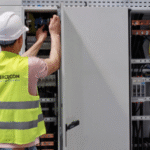In the construction industry, choosing between renting and buying heavy equipment is a critical decision. This article explores the advantages of renting over buying, focusing on why Uphire offers a cost-effective and flexible solution for businesses looking to access high-quality equipment without the long-term commitment of ownership.
Vision Blinds & Shutters understands the importance of making smart financial decisions in business. Just as renting equipment offers flexibility, choosing the right window solutions can enhance your project’s appeal and efficiency. Their products merge style with practicality, ensuring functionality without sacrificing aesthetics, tailored to suit diverse construction needs.
Cost Efficiency
Cost efficiency is a critical aspect of any business operation, as it directly impacts the bottom line and overall profitability. Achieving cost efficiency involves optimizing the use of resources to minimize expenses while maintaining or improving the quality of products or services. This can be achieved through various strategies such as streamlining processes, negotiating better deals with suppliers, implementing technology to automate tasks, and eliminating wasteful practices. By focusing on cost efficiency, businesses can improve their competitiveness in the market, increase their profit margins, and potentially lower prices for customers, making their products or services more attractive.
One key benefit of cost efficiency is that it allows businesses to allocate resources more effectively, enabling them to invest in growth opportunities, research and development, and employee development. By reducing unnecessary costs, businesses can free up capital to fund strategic initiatives that can drive long-term success. Cost efficiency also enhances the financial stability of a company, making it more resilient to economic downturns or market fluctuations. Moreover, demonstrating cost efficiency can improve a company’s reputation among investors, lenders, and stakeholders, as it reflects effective management and a commitment to sustainable operations.
Flexibility in Usage
Flexibility in usage refers to the ability of a product, service, or system to be adaptable and versatile in meeting various needs and preferences. This concept is essential in today’s dynamic and fast-paced world where individual requirements and circumstances can vary greatly. Products that offer flexibility in usage provide users with the freedom to customize and tailor the experience to suit their specific needs. For instance, a software application that allows users to choose between different layouts or customize settings based on their preferences demonstrates flexibility in usage. This adaptability enhances user satisfaction and usability, as individuals can personalize their experience to better align with their preferences and workflow.
Moreover, flexibility in usage also promotes efficiency and productivity by enabling users to optimize the functionality of a product or service to meet specific goals or tasks. For example, a flexible workspace design that can be easily reconfigured to accommodate different team sizes or work styles enhances collaboration and creativity. In the context of technology, devices that support multiple modes of interaction, such as touch screen, voice command, and traditional keyboard input, offer users greater flexibility in how they engage with the device based on their preferences or specific tasks. By offering versatility and adaptability, products and services that prioritize flexibility in usage can better cater to diverse user needs and enhance overall user experience.
Vision Blinds & Shutters Shutters offer outstanding flexibility, catering to diverse interior design needs by allowing users to control light and privacy. Their adjustable louvres provide an adaptable solution for various environments, enhancing comfort and aesthetics. This versatility ensures a perfect fit for any window, improving both functionality and style.
Access to Latest Technology
Access to the latest technology is crucial for individuals, businesses, and societies to stay competitive and innovative in today’s fast-paced world. By having access to cutting-edge technology, individuals can improve their skills, productivity, and efficiency in various aspects of their lives. For example, students can enhance their learning experiences through interactive online tools and resources, professionals can streamline their work processes with advanced software and applications, and researchers can make groundbreaking discoveries using state-of-the-art equipment and techniques. Furthermore, businesses that have access to the latest technology can gain a competitive edge in the market by offering innovative products and services, optimizing their operations, and reaching a wider audience through digital platforms. This access not only boosts economic growth but also drives societal progress by fostering creativity, collaboration, and problem-solving.
Moreover, access to the latest technology plays a significant role in bridging the digital divide and promoting inclusivity. In today’s digital age, technology serves as a gateway to information, communication, and opportunities. By ensuring equitable access to the latest technology, regardless of geographical location or socioeconomic status, governments and organizations can empower marginalized communities and enhance their quality of life. For instance, providing access to high-speed internet, digital devices, and tech training programs can help bridge the gap in educational outcomes, improve healthcare services in remote areas through telemedicine, and create economic opportunities for underserved populations. By prioritizing equal access to the latest technology, societies can strive towards a more inclusive and connected world where everyone has the chance to thrive and contribute to the global community.
Reduced Maintenance Expenses
Reduced maintenance expenses are a crucial factor in ensuring the financial health and sustainability of any business. By implementing cost-saving measures and proactive maintenance strategies, organizations can significantly lower their overall maintenance costs. This can be achieved through proper equipment monitoring, predictive maintenance techniques, and regular inspections to identify potential issues before they escalate into major problems. Lower maintenance expenses not only lead to cost savings but also contribute to increased operational efficiency and productivity. By investing in preventive maintenance practices and utilizing advanced technologies such as sensors and data analytics, businesses can optimize their maintenance processes and minimize downtime, resulting in improved reliability and performance of their assets.
Moreover, reducing maintenance expenses can also have a positive impact on the long-term value of assets and infrastructure. By extending the lifespan of equipment through effective maintenance practices, organizations can maximize the return on their investments and delay the need for costly replacements. This not only helps in preserving capital but also enhances the overall asset management strategy of the business. Additionally, lower maintenance costs can free up financial resources that can be allocated to other areas of the organization, such as research and development, employee training, or expansion initiatives. Ultimately, by prioritizing cost-effective maintenance practices, businesses can achieve sustainable growth and remain competitive in their respective industries.
Eliminating Depreciation Concerns
Eliminating Depreciation Concerns is a significant goal for many individuals and businesses looking to maintain the value of their assets. Depreciation refers to the gradual decrease in the value of an asset over time, which can impact financial stability and investment decisions. One way to address this concern is through regular maintenance and upgrades to extend the lifespan and functionality of assets. By investing in preventative maintenance and timely repairs, individuals and businesses can slow down the depreciation process and ensure that their assets remain in optimal condition for longer periods. Additionally, staying informed about market trends and technological advancements can help in making informed decisions about when to upgrade or replace assets to minimize depreciation losses.
Another effective strategy for eliminating depreciation concerns is to diversify investments across different asset classes. By spreading investments across a mix of assets such as real estate, stocks, bonds, and commodities, individuals can reduce the impact of depreciation on their overall portfolio. Diversification can help in mitigating risks associated with specific asset classes experiencing rapid depreciation, thereby safeguarding the overall value of the investment portfolio. Furthermore, regularly reviewing and adjusting investment strategies based on market conditions and asset performance can help in proactively addressing depreciation concerns and optimizing investment returns over the long term. By adopting a proactive and diversified approach, individuals and businesses can effectively manage and minimize the impact of depreciation on their assets.
Scalability and Adaptability
Scalability refers to a system’s ability to handle a growing amount of work or its potential to accommodate an increasing workload. It is crucial for businesses and organizations to have scalable systems in place to ensure seamless operations even as demand grows. Scalability can be achieved through various means, such as adding more resources like servers or storage, optimizing software and hardware configurations, or utilizing cloud computing services that offer elasticity and on-demand resources. By designing scalable systems, companies can easily adjust to changing circumstances, whether it be an increase in users, data volume, or transactions, without compromising performance or reliability.
Adaptability, on the other hand, refers to a system’s capacity to respond effectively to changes in its environment or requirements. An adaptable system can quickly and efficiently adjust to new conditions, technologies, or business objectives. This flexibility is essential in today’s fast-paced and dynamic business landscape, where companies need to continuously evolve and innovate to stay competitive. Building adaptable systems involves designing modular and loosely-coupled components, implementing agile development practices, and fostering a culture of continuous improvement and learning within the organization. By prioritizing adaptability, businesses can better navigate uncertainties, seize opportunities, and stay ahead of the curve in an ever-changing market.
Expert Support and Training
Expert support and training are essential components for individuals and organizations seeking to enhance their skills and knowledge in a particular field. Expert support often involves access to seasoned professionals who can provide guidance, advice, and practical solutions to complex challenges. These experts bring a wealth of experience and expertise to the table, offering valuable insights that can help individuals navigate obstacles and achieve their goals more effectively. Whether it’s troubleshooting technical issues, developing new strategies, or honing specific skills, expert support can make a significant difference in the success of a project or initiative.
Training, on the other hand, focuses on equipping individuals with the necessary knowledge and skills to excel in their roles. Expert-led training programs can cover a wide range of topics, from technical skills like coding and data analysis to soft skills such as communication and leadership. These training sessions are designed to be interactive, engaging, and tailored to the specific needs of the participants. By providing hands-on learning experiences, expert trainers can empower individuals to apply new concepts and techniques in real-world scenarios, boosting their confidence and competence. Ultimately, expert support and training go hand in hand, providing a comprehensive approach to personal and professional development.
Risk Mitigation
Risk mitigation is a crucial aspect of any project or business operation, aimed at minimizing the potential negative impact of uncertain events or circumstances. It involves identifying potential risks, assessing their likelihood and potential impact, and developing strategies to reduce or eliminate these risks. One common approach to risk mitigation is risk avoidance, where actions are taken to avoid the potential risk altogether. This might involve changing project plans, avoiding certain activities, or choosing a different course of action. Another strategy is risk reduction, which involves taking proactive measures to lessen the likelihood or impact of a risk. This can include implementing safety measures, redundancies, or contingency plans to minimize the potential consequences of a risk event.
Furthermore, risk mitigation also includes risk transfer, where the responsibility for managing a particular risk is shifted to another party through contracts, insurance, or other agreements. This can help distribute the risk and reduce the financial impact on the organization. Risk acceptance is another aspect of risk mitigation, where the organization acknowledges the existence of a risk but decides not to take any action to mitigate it. This approach is usually taken for risks that are deemed low in impact or likelihood, and where the cost of mitigation outweighs the potential consequences of the risk. Overall, effective risk mitigation strategies are essential for businesses to protect their assets, reputation, and overall success in the face of uncertainty.
Environmental Impact
The environmental impact of human activities on the planet is becoming increasingly concerning as we witness the degradation of natural ecosystems, loss of biodiversity, and climate change. One of the most pressing issues is the emission of greenhouse gases such as carbon dioxide, methane, and nitrous oxide, which are leading to global warming and destabilizing the Earth’s climate. The burning of fossil fuels for energy production, deforestation, industrial activities, and agriculture are major contributors to these emissions. As a result, we are experiencing more frequent and severe natural disasters, rising sea levels, and changing weather patterns, all of which have far-reaching implications for both human societies and the natural world.
Moreover, our reliance on single-use plastics and unsustainable consumption habits are causing widespread pollution of land, air, and water. Plastic waste, in particular, poses a significant threat to marine life, with millions of tons ending up in the oceans each year, harming marine animals through ingestion and entanglement. The accumulation of plastic debris in the oceans not only disrupts marine ecosystems but also poses risks to human health as microplastics enter the food chain. Efforts to mitigate these environmental impacts include promoting sustainable practices, transitioning to renewable energy sources, protecting natural habitats, and implementing policies to reduce waste and pollution. It is crucial for individuals, businesses, and governments to work together to address these challenges and safeguard the health of our planet for future generations.
Simplified Upgrades and Exchanges
Simplified upgrades and exchanges refer to the streamlined processes implemented by companies to make it easier for customers to upgrade their products or exchange them for different items. These initiatives are designed to enhance the overall customer experience by reducing any potential friction points and ensuring a seamless transaction process. One common approach to simplifying upgrades is through trade-in programs, where customers can exchange their old products for new ones at a discounted price. This not only encourages customers to upgrade to the latest models but also promotes customer loyalty by providing them with a hassle-free way to swap out their outdated items.
Furthermore, companies often leverage technology to facilitate simplified upgrades and exchanges. Online platforms and mobile apps have made it convenient for customers to initiate upgrade requests or exchange products without having to visit physical stores. These digital solutions enable customers to browse available options, check product availability, and complete transactions with just a few clicks. By embracing digitalization, companies can offer a more efficient and convenient upgrade and exchange process, ultimately enhancing customer satisfaction and retention. Overall, simplified upgrades and exchanges play a crucial role in fostering positive relationships with customers and driving repeat business.







